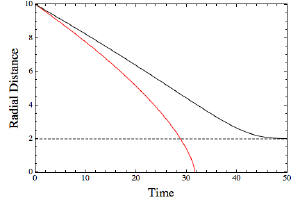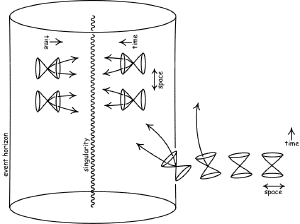Blog
Lies My Teacher Told Me
21 January 2015
Yesterday I got an email outlining why black holes can’t possibly exist. Those of you who are regular readers might be quick to point out that black holes most certainly exist, but the author is right. Black holes make no sense. I, and other scientists, have been lying to you all along.
As the author clearly points out:
If time dilation increases the closer one approaches the event horizon of a black hole and from our perspective we see time essentially stop at the event horizon, how will a black hole ever form in our universe if nothing can ever cross the event horizon relative to us and the rest of the universe?
The explanation used for the creation of a black hole is that gravity increases due to an increase in the density of the material within the stellar object. Since gravity is many orders of magnitude less powerful than even the electrical forces being experienced between the nuclei of the matter in question how does the gravitational force overcome the repulsion between nuclei. I understand that the electrons will provide some neutralisation of the positive charges. However, even in standard forms of matter there are various electrical forces that occur, even though the atoms are technically neutral.
Thirdly, the event horizon is defined where the escape velocity is defined as being the speed of light. However, the escape velocity is defined by a specific criteria and circumstance, which is clearly understood in engineering circles does not apply to powered movement. That is the actual velocity by which you transition from from solar body to another can be as low as you like. Hence, you can cross any boundary, including an event horizon, under power at any speed (under the speed of light).
It seems very clear then that black holes defy logic, so why do we scientists keep claiming they exist? Because the arguments outlined above are based on a pack of lies.
When I say that I’ve been lying to you, this doesn’t mean I’ve intentionally tried to deceive you. It means that I’ve been intentionally feeding you information that isn’t entirely true in order to give you an understanding of what is really going on. For example, take these three points.
From our viewpoint, stuff takes forever to fall into a black hole, so a black hole can never form.
 Brian Koberlein
Brian KoberleinOne of the standard things said about black holes is that as material falls into a black hole it will be seen from the outside to never quite reach the event horizon. While this is true, it’s also true that from the viewpoint of the material it readily crosses the event horizon. What we often leave out in this discussion is that this is a rather simplistic description of the situation from only two vantage points. One of the central aspects of relativity is that all vantage points are valid, even when they seem contradictory. What this means is that to really describe the situation you have to look at all of spacetime as a whole. When you do this, it is clear that matter really does cross the event horizon, and black holes really do form. From the material’s vantage point you can see this, but from the exterior view you can’t. Of course to describe the whole of spacetime requires tensor calculus, so we typically omit that from the popular science tale.
Gravity is weaker than electromagnetism.
Again, at a basic level this is true. Certainly if we were to put two protons close to each other, the repulsive force of their electric charge would be much, much stronger than the attractive gravitational force due to their masses. That would seem to contradict the common claim that black holes form when a star’s gravity causes it to collapse under its own weight. But gravity doesn’t cause a star to collapse. It’s the electric force that does it. Imagine a table standing in the middle of a room. The atoms and molecules of the table interact with each other through electric forces, which is what gives the table its rigidity. The table is perfectly capable of supporting its own weight, because the electric forces are much stronger than gravity. But suppose I were to start stacking books on the table. Eventually the weight of the books would cause the table to collapse.
In that case, what caused the table to collapse? Gravity? No, it’s actually the force of the books right on the table’s surface. They push on the table so strongly (with the electric forces of the atoms and molecules) that the table can’t withstand it. Granted, the lowest books can push so hard because books on top of it are pushing on them, and all of this is due to gravity giving each layer of books a little tug. But technically gravity doesn’t cause the table to collapse, gravity just helps the electric force build so that it collapses the table. The same is true with a collapsing star. It is the electric and nuclear forces pushing against each other in the interior that cause the collapse. Gravity just helps those forces work together.
But all of that is complicated, so we usually just say “gravity causes the star to collapse.”
The event horizon is where the escape velocity is the speed of light, but that doesn’t keep us from escaping with a slower than light rocket.
This is one of the biggest lies we tell about black holes. On one level it is true. If you calculate the escape velocity at the event horizon (according to Newtonian gravity), then it is the speed of light. It makes for a simple way to describe black holes and event horizons. The problem with the idea is that escape velocity is defined as the speed it takes to escape forever. But if I tossed a ball at just under the escape velocity, it would rise very, very high before falling back down. Using escape velocity gives the impression that a rocket could escape, just as we use rockets to escape Earth’s gravity.
 John D. Norton
John D. NortonBut in relativity, the energy of the rocket would actually work against you. To really look at the structure of a black hole, you need to look at how light behaves globally. This is often visualized using light cones to show the effects of gravity. When you look at the details you find that while the event horizon does have a light-speed escape velocity, what really makes it different is that it folds space to the point where there is no possible trajectory where you can leave. All roads lead to Rome, as the saying goes, or in this case to the singularity. So if you were really at the event horizon of a black hole, any direction you tossed a ball would be “downward,” and it would be physically impossible for you to toss the ball “up.”
So the author is right about black holes not being logical, if what we typically say about black holes were actually true. But they aren’t. And therein lies one of the dangers of popularizing science. To make things clear, we often simplify things to the point where they aren’t fully true. We lie a bit to convey the central ideas rather than getting bogged down in the details. That’s fine if you just want to get a basic understanding of things. But it’s important to keep in mind that the analogies we use shouldn’t be taken literally.
When you find contradictions in the pop-science description of an established scientific idea, it doesn’t mean the science is wrong, it means the truth is more complicated than we’ve been letting on.